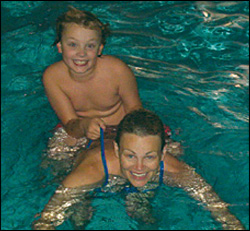
Am Fam Physician. 2007;76(6):796

My mother had perimenopausal breast cancer at age 51. I have three older sisters. I guess none of us ever figured I'd be the one. I had a baseline mammogram, and they called me the next day. They said, “You have calcifications everywhere.” They thought it was ductal carcinoma in situ (DCIS). I had genetic testing three days after the diagnosis. I thought I'd use that to decide whether to have a unilateral or bilateral mastectomy. But they want to hurry you along, get you in surgery, especially if you're young. I had to decide before the results came back. So I finally made the decision by talking with a plastic surgeon and a breast surgeon. I chose bilateral mastectomy.
Initially, my doctors didn't think I needed chemotherapy, because there was only a 10 percent chance that cancer would be in my lymph nodes. But I did need it. Usually they recommend sentinel node biopsy for DCIS instead of a full lymph nodectomy. The chance of being lymph-node positive is pretty low. A pathologist comes into the surgical unit and does the test right there, so that if the result is positive, they know they have to do the full lymph nodectomy. There's about a 25 percent chance that even though a sentinal node is negative, another node will be positive. That's why my surgeon thought she'd feel around—through a one-inch incision in my areola! A node that didn't have any dye in it felt hard. It wasn't large or sticky. That one turned out to be positive. My sentinel nodes were negative. If my surgeon had just done a classic test she would have missed it. But she said she always feels around to be sure.
All along the way, there were so many decisions to be made. Some of these were resolved by chance. Others required on-the-spot decision making. If you don't have a medical background, you just have to take the advice you're given and hope for the best.—j.k., 37
COMMENTARY
An editorial notes that the goal of medical decision making is not to make decision making easy, but to make it difficult; to ensure patients understand that every decision has uncertainty and risk.1 J.K.'s story reminds us that shared decision making, although a patient-empowering approach in the spirit of the ethical principle of patient autonomy, can be stressful and painful. It certainly does not always occur seamlessly. One study showed perceived barriers to successful shared decision making in breast cancer treatment included lack of time as well as patients' anxiety, lack of information, and unwillingness or inability to participate.2 Facilitating factors included patients' emotional readiness, support, information, and trust.